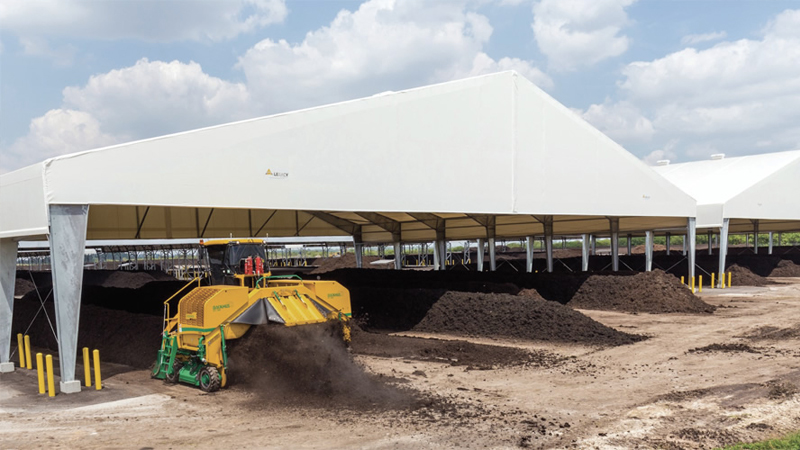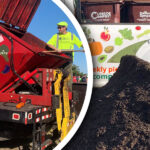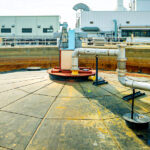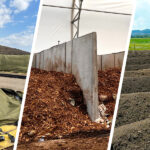Nora Goldstein
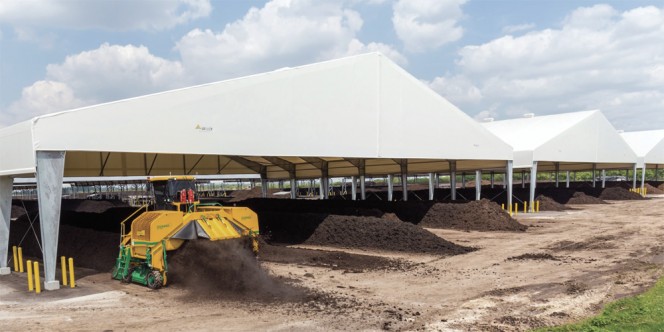
As part of its expansion, three 162 feet by 120 feet Legacy Building Solutions’ fabric structures, with a clearance height of 18 feet, were installed for processing and curing. Each building has capacity for about 6 windrows (about 1,700 cubic yards). Lee County also purchased a second Ecoverse windrow turner. Photo courtesy of Legacy Building Solutions
The Lee County, Florida Solid Waste Division opened a biosolids composting facility at its landfill in Felda in 2010, providing an opportunity to divert a portion of the biosolids generated in the county from disposal. Its initial windrow composting facility was designed to process 20,000 wet tons/year of biosolids and 20,000 tons/year of ground yard trimmings.
Prior to moving ahead with the facility, the county conducted a small-scale windrow composting pilot to test the feasibility of the process and evaluate the viability of composting as an alternative to landfilling the biosolids. Lee County Utilities, which provides wastewater treatment services, had initially rejected composting as a management option in 2006, citing a “poor operating track record” and problems with regard to “odor containment and control.” As a result, it decided to proceed with a biosolids thermal drying facility, which never came to fruition due to the high capital and operating costs. “Our landfill disposal option was cheaper,” notes Keith Howard, Deputy Director of the Lee County Division of Solid Waste.
“However, we were encountering some disposal headaches with the biosolids, especially related to moisture content of the material, and the county ultimately agreed to proceed with the biosolids composting pilot, and eventually the full-scale operation.”
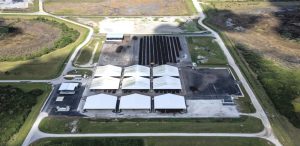
Ten acres of the composting site were upgraded for use as curing pads (top of photo). The three new structures (foreground) are on a 2.75-acre pad.
The facility that opened in 2010 consisted of six 16,000-square-foot single span open-sided fabric structures. “We decided to cover the windrows because we get six months of rain and six months of sun and dry winds,” says Howard. At the time, most yard debris generated in Lee County was mulched and land applied. A Backhus (now Ecoverse) windrow turner was purchased along with a hose reel assembly to add moisture during turning. Capital costs were about $3.5 million. Initially, the compost was used for landfill closure. Gradually, however, Lee County began developing markets for the compost.
“Area farmers, including orange groves, tried the compost, and found that it is an inexpensive source of nitrogen and phosphorus,” he explains. “And they recognize the additional benefits of water retention and increased organic matter in the upper strata of the soils. Most of the farmers are applying 1 to 2 tons/acre — like a dusting — although some are applying 4 to 6 tons/acre. Current research at the University of Florida is finding that the compost application may improve the citrus plants’ resistance to citrus greening and citrus canker disease.”
The biosolids compost is sold for $9.75/ton plus delivery charges. “We have a pretty big solid waste division, with two transfer stations, and are hauling regularly from one facility to the other, so offering compost delivery fits into our regular routines,” notes Howard. “We normally use a rear dump truck for orders of 25 cubic yards (cy), and walking floor trailers with about 50 cy capacity for larger loads.” In addition to farmers, Lee County sells compost in bulk to homeowners and commercial landscapers. A small portion of the compost is bagged.
In 2010, the Florida Department of Environmental Protection revised its biosolids regulations, which became effective in January 2013. The new rules restricted land application of biosolids in the Okeechobee Watershed. About half of Lee and Hendry Counties resides in this watershed, specifically the Caloosahatchee River watershed that is a part of this natural system. Only Class AA biosolids products that are registered as a fertilizer may be utilized. “Our compost meets the Class AA requirements, and most of our Lee County customers are within the Okeechobee/Caloosahatchee Watershed, so we decided to register the compost as a fertilizer,” he explains. “We have to pay a fee of $1.50/ton, but being classified as a fertilizer works well from a marketing and distribution perspective.”
Composting Operations
Wastewater treatment plants within the Lee County Utilities service area, including the cities of Fort Myers and Cape Coral, generate about 40,000 to 50,000 wet tons/year of biosolids. About 50,000 tons/year of yard trimmings are generated by the residential sector, and about 30,000 tons/year are generated by the commercial sector. The yard trimmings are ground on a 6-acre pad at the county’s waste-to-energy plant. A contractor comes in every two months and grinds the material using a Diamond Z tub grinder to meet the county’s specifications of a 2-inch minus particle size. “A lot of the material is palm fronds and palm trees,” says Howard. “Even with the 2-inch grind we get a lot of pieces that are long and stringy, which actually works well in our process. They help maintain the porosity of the pile, and they do break down.”
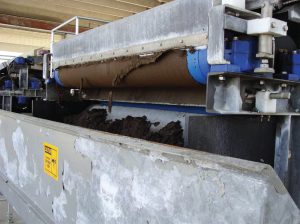
Biosolids are dewatered to about 15 percent solids by the wastewater treatment plants, and then hauled to the composting facility when they are blended with yard trimmings ground to a 2-inch minus particle size.
Ground yard trimmings are mixed with biosolids (dewatered by the treatment plants to about 15% solids) in a 1.5 to 2:1 ratio. Windrows are constructed with a front-end loader, starting with a layer of screened overs, then biosolids and then yard trimmings. “We build the pile about half-way, then run the turner through, before building the rest of the windrow,” he explains. “The completed windrow is 9-feet high by 16-feet wide.” Windrows are turned daily for the first 15 days, and then moved to a “curing pad” where the material continues composting. Turning is done as needed, depending on pile temperature, porosity, carbon dioxide readings and pile “slumping.” Prior to relocating the materials to the “curing pad,” all operations are conducted under the fabric structures.
“We learned early on that customers liked the consistency of the product we were making — the compost has 40 percent moisture content and is ready to spread,” notes Howard. “In order to provide that consistency, we had to sacrifice some of our building space for storage post-screening. Another building was used to dry compost prior to screening. It became obvious that in order to process more biosolids and yard trimmings, we needed to add more structures.”
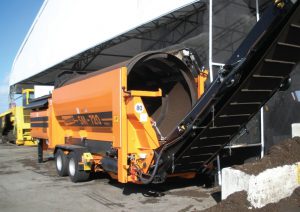
Lee County has two Ecoverse trommel screens. Compost is screened to about a half-inch particle size. “Groves like that size because it has a slightly larger texture,” says Keith Howard, the county’s Deputy Director of the Division of Solid Waste.
Lee County applied for its composting permit renewal and an expansion permit in August 2013. Both were granted, and construction began in April 2014. In addition to upgrading 10 acres of the site for use as curing pads and another 2.75-acre pad for processing/curing, the bid documents for the project included three new fabric structures. Each structure was required to have a minimum, obstruction-free height (18 feet) and width (156 feet) beneath the canopy. The bid documents included site plans and a performance specification for the buildings that required a 15-year warranty including corrosion protection. The contract was awarded to Thalle Construction. Thalle selected Legacy Building Solutions, which installed the three fabric buildings, each 162 feet by 120 feet, with a clearance height of 18 feet (providing capacity for about six windrows or 1,700 cy/building). The structures utilize a rigid-frame engineering concept where the fabric exterior is applied to steel I-beams. The steel trusses support 380 pounds of ceiling fans; ventilation is aided by the inclusion of four ridge vents. All steel members are hot dip galvanized for added corrosion protection; the 28-ounce PVC-PVDF fired-rated fabric provides enough translucency to eliminate the need for electric lights inside the structures during daylight hours.
“Adding the three buildings almost doubles our production space, including capacity for blending feedstocks and building rows,” says Howard. “We will be able to increase throughput of biosolids to close to 50,000 wet tons/year, or almost 100 percent of the biosolids that we are under contract to manage. The new structures were built on our old curing pad, which wasn’t configured correctly for optimum storm water drainage. Previously, the piles were built from east to west, which made sense from an efficiency standpoint, but during the rainy season from August to October, there was a lot of ponding and puddles. The new buildings are oriented from north to south, so water flows through the proper way.”
With the facility expansion, Lee County purchased a second Ecoverse turner and a second Ecoverse trommel screen. Compost — Seal of Testing Assurance certified — is screened to five-eighth inch, which yields about a half-inch particle size. “Groves like that size because it has a slightly larger texture,” adds Howard. “And residential users seem to like it as well.” Much of the compost produced is presold; about 30,000 tons/year are manufactured. The facility, which employs six people, builds up its compost inventory in the August to October timeframe, during the rainy season. “Once it stops raining, we can start screening,” he notes.
Lee County charges a tipping fee of $24 for yard trimmings, and $26 to $27/wet ton for the biosolids. Operating costs are in the “low $20s” and combined with compost sales, “we are running in the black,” says Howard.


